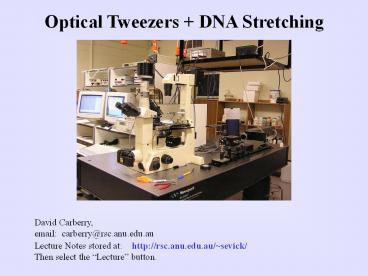Optical Tweezers DNA Stretching - PowerPoint PPT Presentation
Title:
Optical Tweezers DNA Stretching
Description:
With the proper detection equipment they can be capable of ... Refraction: Snell's Law. Photons. h = 6.626 * 10-34 J.s. c = 3.0 * 108 m.s. l = wavelength ... – PowerPoint PPT presentation
Number of Views:324
Avg rating:3.0/5.0
Title: Optical Tweezers DNA Stretching
1
Optical Tweezers DNA Stretching
David Carberry, email carberry_at_rsc.anu.edu.au
Lecture Notes stored at http//rsc.anu.edu.au/
sevick/ Then select the Lecture button.
2
What are Optical Tweezers?
Simply put a device that uses light to control
and manipulate objects. With the proper
detection equipment they can be capable of
measuring very small forces (as low as 10 fN, or
10-14 N)
Applications for Optical Tweezers
- Cell sorting
- In vitro fertilisation
- Laser atom cooling
- Orbital Angular Momentum expts
- Thermodynamics Research
- Stretching DNA
- many more
3
Refraction Snells Law
Photons
h 6.626 10-34 J.s c 3.0 108 m.s l
wavelength
Very small individual momentum contributions, but
becomes significant when used in large
concentrations.
4
Thermal Energy
All matter has a thermal energy of
per degree of freedom. kB Boltzmann constant,
1.3806503 10-23 J.K-1
Laser Profiles
- Different laser profiles depending on the type
of application, characterised by the term TEMxy. - Most common is a Gaussian profile, TEM00.
- Other profiles offer different functions,
- eg optical vortices.
5
Combining these ideas
This last image indicates how the Optical
Tweezers work.
6
Optical Traps as Potential Wells
7
Stretching Polymers Using Optical Tweezers
8
Why Stretch DNA?
- If we know the forces applied when stretching a
chain, and we change the system, then we can
determine the forces and energetics due to that
change. - F(DNA protein) - F(DNA) F(protein)
- F(DNA salt) - F(DNA) F(salt)
- The force profile of the protein leads to a
better understanding of how the protein operates
and the conditions it requires manipulate it. - The effects of other solvents and interactions
can be tested.
9
How to Stretch DNA
1. Prepare DNA ends to have two different
labels 2. Prepare particles with two different
surface chemistries 3. Mix DNA with particle type
1 (say green) 4. Capture particle type 2 in a
micropipette (ie yellow) 5. Move green particle
close to yellow particle using optical tweezers
and HOPE IT WORKS!
10
Progress so far
Can hold particles in micropipette easily. But
forming a link is very difficult.
11
Preliminary Results
We do have a few results, an example is shown
here. But the difficulties mean we need to work
further on improving the experiment.
12
In summary
Optical Tweezers use the refraction of light to
trap and manipulate microscopic particles. By
measuring the position of the particle we measure
the force exerted on the particle. Using these
particles we can investigate many different
properties, DNA stretching being just one. DNA
stretching is difficult to achieve, but then
again we are manipulating one molecule at a time.
Lecture Notes stored at http//rsc.anu.edu.au/
sevick/ Then select the Lecture button.































